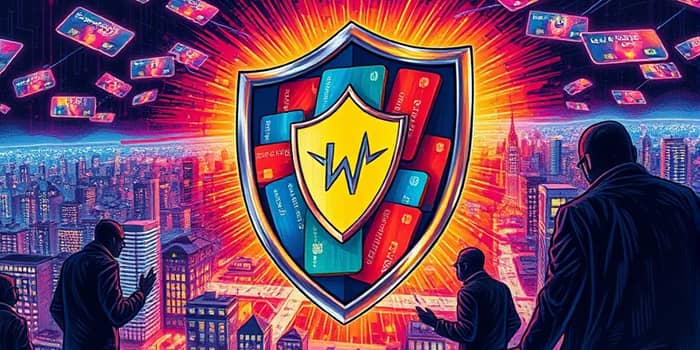
In an era where plastic and digital wallets dominate everyday transactions, credit card fraud poses an ever-growing risk. As fraudsters refine their tactics, individuals and businesses alike face the specter of unauthorized charges and stolen identities. Understanding the breadth of this threat is the first step toward safeguarding your finances and peace of mind.
With global losses escalating and new vulnerabilities emerging daily, it is paramount to arm yourself with knowledge and practical strategies. This comprehensive guide delves into the scale of the problem, illuminates who is most at risk, explores the methods criminals employ, and equips you with actionable defenses to keep your credit card information secure.
Over the past decade, credit card fraud has climbed at an unprecedented rate. Experts forecast that global fraud losses will reach $43 billion by 2026, compared to $9.84 billion in 2011—a staggering 4.5x increase over fifteen years. Despite advanced security measures in place, the United States alone accounts for 46% of global credit card fraud, underscoring that no region is immune.
In the U.S., ecommerce merchants have witnessed a 140% surge in fraud attacks over just three years. Meanwhile, consumers are not spared: recent data shows that 62 million Americans grappled with unauthorized charges, collectively totaling $6.2 billion in losses. Financial institutions and retailers are investing heavily in fraud detection, but responsibility also rests with cardholders to stay vigilant.
Credit card fraud casts a wide net, touching individuals across all walks of life. In a single year, the FTC recorded nearly 2.6 million reports of fraud, with credit card scams constituting 40% of those incidents. While fraud impacts all age groups, certain demographics face higher vulnerability.
Millennials (ages 20–29) are statistically more likely to fall prey to scams, with 44% of those reporting fraud losing money, compared to 24% of senior victims. Ironically, older adults often suffer larger monetary losses per incident. Alarmingly, 63% of U.S. cardholders have experienced fraud, and 51% encountered fraud multiple times—revealing a pattern of repeat victimization.
Fraudsters deploy a variety of methods to steal card information. Recognizing these techniques is critical for prevention:
Only about 8% of fraudulent charges involve physically stolen cards; the majority arise from remote theft of data. Furthermore, 21% of victims report recurring unauthorized charges from the same merchant, indicating weaknesses in recurring payment systems.
The fallout from credit card fraud extends beyond immediate financial loss. Victims often endure a lengthy dispute process with issuers, which can strain personal finances and credit limits.
In some cases, delayed resolution harms credit scores due to incorrect reporting or lingering balances. Victims must also navigate the cumbersome process of filing reports, freezing accounts, and monitoring for secondary identity theft. The emotional toll—stress, anxiety, and loss of trust—can be just as significant as monetary damages.
While the threat landscape evolves, there are proven defenses you can implement today to fortify your financial security. Adopting a multi-layered approach makes unauthorized charges far less likely and ensures faster detection when they occur.
In addition to these steps, ensure you:
Use mobile wallets like Apple Pay or Google Pay, which secure transactions with encryption rather than exposing raw card details. Always transact on websites that employ encrypted data transfer with https, and maintain up-to-date antivirus software on all devices. Stick to dedicated cards for recurring payments, so you can disable them without disrupting daily spending needs.
Day-to-day behaviors can inadvertently increase your exposure to fraud. Awareness of these risky habits helps you break patterns that attract scammers:
By consciously replacing these habits—using unique passwords, employing a VPN on public networks, shredding sensitive paperwork, and checking statements promptly—you drastically reduce opportunities for criminals.
Even the most vigilant individuals can fall victim to sophisticated fraud schemes. If you notice unauthorized charges, contact your card issuer immediately. Under zero liability policies with most issuers, you typically bear no financial responsibility for fraudulent transactions.
Request the fraudulent charges to be reversed and ask for a new card to prevent further unauthorized use. Next, place a fraud alert or credit freeze by contacting all three credit bureaus—Equifax, Experian, and TransUnion. This measure hinders criminals from opening new accounts in your name.
File a complaint with the FTC, providing details of the incident, and consider filing a report with local law enforcement if identity theft is suspected. Continue monitoring your accounts diligently for recurring or related fraudulent activity, and review your credit reports at least once a year to spot any irregularities early.
Fraudsters constantly innovate, developing new schemes such as synthetic identity fraud, where real and fabricated information merge to create seemingly legitimate profiles. Automated bots probe for card data during online checkout, and contactless transactions lure criminals seeking quick skimming opportunities.
On the flip side, financial institutions are leveraging artificial intelligence and machine learning to detect anomalies in spending patterns, often flagging suspicious activity before it escalates. As technology advances, the battle between fraudsters and defenders hinges on staying informed, adaptable, and proactive.
Credit card fraud is an escalating threat with far-reaching consequences. However, by understanding how scams operate, recognizing personal risk factors, and deploying layered defenses, you can reclaim control over your financial security. From simple habits like reviewing statements to advanced measures such as credit freezes and biometric authentication, every action counts.
Stay vigilant, embrace best practices, and educate those around you—friends, family, and colleagues—so that together, we can build a more secure financial environment. After all, protecting your credit card is not just about safeguarding numbers; it is about preserving trust, security, and peace of mind in an increasingly digital world.
References













